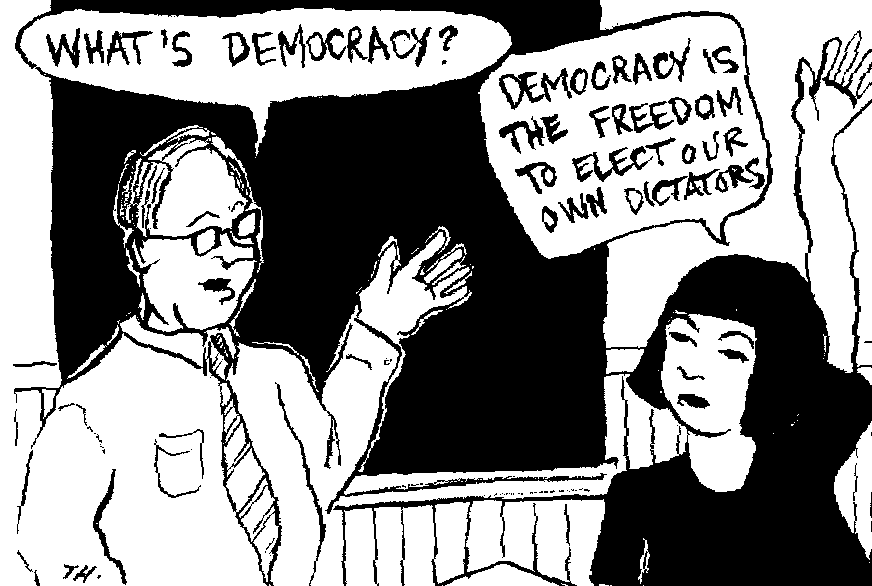The Economist ~ Alliance life-cycles
 •
by
•
by Spite313

Dear friends,
Just another
In eRepublik politics (like everywhere else) power is distributed amongst all of the people in the game. Political power is vested in each individual player, but because of the enforced republican system of government, that power is only directly exercised three times a month. At that time power is transferred from citizens to elected officials- namely congress and the CP. The roles of these two bodies differ from country to country, but in most cases the President is also chief diplomat, head of the army and the representative of the country internationally. In fact the eRepublik admins have long recognised this by giving the CP exclusive access to national organisations and the power to ticket them on behalf of the whole country.

In this case there is a direct link between the President and the player. Power is vested directly, and so it can be claimed that the CP has a popular mandate. It might be a stronger mandate if we had a better voting system, so the CP always had more than 50%, but you know what I mean. The point is accountability and representation.
Alliances form when countries with mutual interests work together. But this meshing of interests is nothing more than a multi-directional diplomatic channel. A true alliance has a separate leadership which assumes responsibility for the direction of all the countries in the alliance. In theory this HQ is usually elected by the members, but in reality the elected individuals are nearly always picked from a small group of well-respected and powerful individuals from the member states. This is where the above democracy diatribe comes in- the ordinary citizen has no say in the election of a HQ, yet the HQ in many ways will be deciding the fate of their country.

The second most centralised state in the world, after North Korea
😛
Centralisation
The first stage of an alliance forming is the gradual centralisation of power from CP level to alliance level. As each individual country signs up to an alliance they pass control of everything from national armies to external diplomatic relations upward to the alliance. As the alliance becomes more centralised, this trend deepens.
In many cases the HQ will set orders which must be followed by countries. These orders will routinely result in the sacrifice of one country over another. An alliance HQ has to make decisions viewing the alliance as a single body, and so often the strategic goal is an unpopular one. The most obvious example of this is the “‘Country A’ is selfish” argument. Whether it is Poland, Croatia, Serbia or the USA there are countries in every alliance that get accused of being selfish or taking all the priority. The truth is that no HQ is going to sacrifice their biggest and most powerful members for a much weaker one. But again this is one of the consequences of centralisation.
Another consequence however is long term planning. A HQ can make plans which span months in a way CPs can’t really. A strong and well equipped HQ can direct multiple nations through quite complex manoeuvres in order to cripple the opposing alliance. The most obvious examples of this are multiple-front attacks, such as the ones against Serbia recently, or more distantly the ones ONE or PEACE brought to bear against the USA. The other truism is that the only way to beat an alliance is with another alliance.

So how do alliances form?
There is never a situation where there is no alliance, it is more a case of how centralised or decentralised an alliance is. In it’s weakest format an alliance is simply a set of MPPs and single-channel communications between Presidents of friendly countries. The progression from this stage to a more centralised stage is always the consequence of one thing: an external threat. The greater the threat, the faster and more complex the centralisation.
The perfect example of this is EDEN. When it was founded it was supposed to be a “brotherhood”. No country taxes, no HQ, no complexity- just allies hanging out together. But by the end of the PEACE annexation of the USA EDEN had been forced to greater levels of complexity, and by mid-2010 it was a full blown alliance. We can see now a similar situation with the ex-ONE countries. They have a certain level of interaction now, but it’ll take a major catastrophe to force greater integration. No CP likes to give up their personal control, and every CP wants to get the best out of that deal that they can.

...And how do they die?
Alliances die the same way they’re born. Lack of external threats, power shifting back towards the CPs, a weak HQ- these are the three major indicators that an alliance is going to die. One of the main reasons EDEN survived so long is the constant threat provided by it’s neighbours in the Balkans. Without that it wouldn’t have lasted so long.
A weak HQ is another issue. As the alliance ages and achieves its goals, the playerbase responsible for it also ages. It gets to a stage where new blood is needed, and if the new leaders aren’t strong or skilled, the alliance weakens very quickly. Often at the end of an alliance the old players step in again in an attempt to save things, and sometimes it works. More often though it is too late by that stage.
Strong CPs are the final death blow usually. So long as CPs are working through the HQ there is a modicum of control there. Once CPs start communicating directly with each other, it usually means the end. Obviously this level of communication is not good enough to deal with a major threat, but with the lack of an external enemy to unify the alliance, this decentralised system is usually fine. The allies go into a long period of quiet until the next great threat comes along.

Conclusions
Alliances are living things, and as such they move and change depending on the situation they face. In some cases they die outright, in other cases they metamorphose- keeping the same name and logo but changing internally a great deal. Either method works, though there are benefits to both approaches.
Centralisation and decentralisation of power between the legitimate elected officials (CPs) and alliance bureaucrats (HQ) mark these changes in alliances. A decentralised brotherhood type alliance only lasts so long as the whole isn’t badly threatened. Centralised power is more efficient but less flexible, and relies on a core group of super-active players to direct it.
The main criticisms of alliances are a lack of accountability and the willingness to sacrifice certain members. These however are also the main strengths of alliances. At the end of the day it is always a balance between the need to achieve damage and the acceptance of the negatives that come with this. Alliances grow strong during crisis points and weaken during peacetime.
Even when the threat isn’t immediately present however, complacency can have severe consequences.
Hope you enjoyed the article, I’d love to hear your thoughts.
Iain



Comments
http://i331.photobucket.com/albums/l479/celticmise/F09AB2B0-081C-442E-B39E-80BF0FC42F6A-7468-00000897DFF9C37B.jpg
Pole! Good Article...
an alliance will die when nobody trust oldfags and everybody think they are better than them !
Or when something bad happen to having patience 🙂
i believe PHX and ONE died because of these 2 reason as main reasons and some more which i'm lazy to type 😛
Good & interesting article and agreed with fagyan.
Building trust & keeping trust is very slow and difficult. Trust however can be demolished quite fast. You need to have a lot of persons that have patience, focus on the long run and that take care of problems to keep your alliance working.
Good article : )
worth reading
interesting
Agreed on most points.
The thing I have been wondering the last few weeks or even months if there is some more flexible brand new alliance structure which would automatically adapt to the factors you mentioned. Obviously I am yet to come to my own conclusion in this matter but I can say I have some ideas.
Well we've tried quite a few times now Kulgar but I'm not so cynical that I don't believe there is a solution 😛
The thing Ariyan says has some truth it as well. When either a weaker "new blood" comes, or at least a new group of individuals which were not part of the founders, tensions usually arise between them and the so called oldfags.
When I assumed the SG position of ONE this summer, it was solely for one reason. Give the alliance a fast and swift coup de grace and let the countries be freely on their way. Obviously with maintaining as close communication as possible.
And here I came to one other thing I strongly believe. Somewhy, somehow governments tend to depend on the alliance HQs too much after a time. It is possibly because after founding an alliance the HQ is usually pretty strong and insanely active and as the country govs founded the alliance together those officials have strong ties and superb communication. But with time this - in my experience - worsens.
After the birth of an alliance there is both Gov-HQ and Gov-Gov communication opposed to any other situation: mainly or exclusively Gov-HQ in the case of an old alliance, and only Gov-Gov in the case when there is no alliance.
At the end I have to say I really enjoyed the article. One time I might get my thoughts together and write a similar one.
I do not read short articles on sunday... monday is day for reading short articles like this one. So... now you can get only vote...
P.S.
but I am sure you writed some true wisdom 🙂
~hyuu~
Will read it tomorrow
biaches , if you dont read, dont spam xD trolololol
true story, voted
vote
why are PHX died, an why ONE? same reason. poland make new alinace, where they dont need to take care abouth small. not even one other countrey is so selfish as poland!
they just care abouth 10/10 thats all what they are interested in...
vote!
vote!